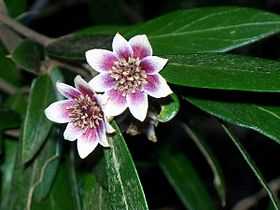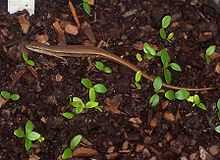Atherosperma moschatum subsp. integrifolium
| Southern Sassafrass - narrow leaf form | |
|---|---|
 | |
| Southern Sassafras at Leura, Australia | |
| Scientific classification | |
| Kingdom: | Plantae |
| (unranked): | Angiosperms |
| (unranked): | Magnoliids |
| Order: | Laurales |
| Family: | Atherospermataceae |
| Genus: | Atherosperma |
| Species: | Atherosperma moschatum |
| Subspecies: | A. moschatum subsp. integrifolium |
| Trinomial name | |
| Atherosperma moschatum subsp. integrifolium (A.Cunn. ex Tul.) Schodde | |
| Synonyms | |
| |
Atherosperma moschatum subsp. integrifolium is a small evergreen tree native to the temperate rainforests of central and northern New South Wales, Australia. In 2006 it was recognised as a separate sub-species by Richard Schodde.[1] Common names include the Southern Sassafras - narrow leaf form or Blackheart Sassafras.[2]
Distribution
Found in four areas; Monga National Park, Blue Mountains, Barrington Tops and at Mount Grundy west of Port Macquarie, by streams such as the Tia River. It may also be undiscovered in the Illawarra to the south, and New England National Park to the north.[3] The original specimen was collected in the Blue Mountains.[4][5]
Genetic Study
Genetic studies of the subspecies, along with the more widespread southerly distributed subspecies, Atherosperma moschatum subsp. moschatum, have shown that populations of the subspecies integrifolium are the most strongly diverged of all populations within the range of the species at both isozymes and chloroplast DNA. These results are consistent with long term isolation of these populations through at least the last glacial period.[6][7]
Habitat
The habitat is cool, moist protected areas; ranging from 650 to 1540 metres above sea level, near streams. Almost always seen growing with the Black Olive Berry. Often found on the richer volcanic soils, but it also grows in sandstone slot canyons where it may be in a dwarf form. An uncommon or rare plant, it may be seen at the Mount Tomah Botanic Garden west of Sydney. Or on the Neates Glen walk at Blackheath.[8]
Description
The Southern Sassafras is a shrub or a small tree, growing from 1 to 30 metres tall.[9] The trunk is not buttressed, somewhat cylindrical. The bark is fairly smooth with bumps and lenticels, often also marked with moss and lichen. Young shoots and new growth is noticeably hairy. A scented and beautiful tree, especially when in flower.[10]
Leaves are narrower than the more southern form of Atherosperma moschatum subsp. moschatum, and many of the leaves are entire, though some small prickles grow on a minority of leaves. Leaves opposite on the stem; 8 cm long, 1 cm wide, white underneath. Glossy above and veiny.[2] Pleasantly scented when crushed.[11]
Flowers and regeneration
Flowers form in winter, facing down to avoid rain and snow. White petaled; and yellow and maroon in the centre. The fruit capsules mature and open around January, releasing feathery wind blown seeds. Germination is unreliable.[2] However, abundant new seedlings may unexpectedly form. Seedlings are unlikely to survive at lower altitudes.
Gallery
-

leaves at Leura, Blue Mountains National Park
-

underside of leaves at Leura
-

seedlings
-

non entire leaves at Monga National Park
-

the northern most limit of Atherosperma, Mount Grundy, west of Port Macquarie
References
- ↑ Australian National Botanic Gardens. "Atherosperma moschatum subsp. integrifolium". Retrieved 1 September 2011.
- ↑ 2.0 2.1 2.2 Floyd, A.G., Rainforest Trees of Mainland South-eastern Australia, Inkata Press 2008, ISBN 978-0-9589436-7-3 page 83
- ↑ Anders Bofeldt - personal communication
- ↑ "Australian Plant Name Index (APNI)". Atherosperma elongatum Gand. Retrieved 2 September 2011.
- ↑ Worth, James. "Atherosperma". University of Tasmania.
- ↑ "Atherospermalast=Shapcott". University of Tasmania.
- ↑ Worth, James. "Low but structured chloroplast diversity in Atherosperma moschatum (Atherospermataceae) suggests bottlenecks in response to the Pleistocene glacials". Annals of Botany. Oxford Journals. Retrieved 15 August 2012.
- ↑ "Picasa - Atherosperma at Neates Glen".
- ↑ Floyd, A.G., Australian Rainforests in New South Wales Volume 2 - 1990 ISBN 0-949324-32-9 page 175
- ↑ A.G.Floyd personal communication
- ↑ "Atherosperma moschatum". Plant Net. Royal Botanic Gardens, NSW Government. Retrieved 1 September 2011.